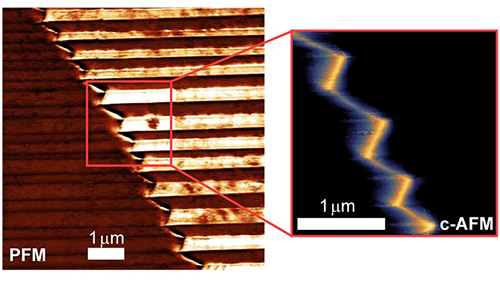| Jul 20, 2021 |
Conductive domain walls with promising functionalities
(Nanowerk News) Researchers from the University of Augsburg and ETH Zurich have discovered giant conductivity of nanometre-sized domain walls separating polar regions in a non-oxide ferroelectric material.
|
|
The high sensitivity of these walls to applied magnetic fields enables gigantic switching of the sample resistance, thus providing a route to new nanoelectronic building blocks. Such behaviour is unprecedented in non-oxides, which are less hampered by defects and deviations in composition than oxides.
|
|
Materials that exhibit a spontaneous electric polarization are called ferroelectrics. The polarization originates from the parallel alignment of electrical dipoles. Ferroelectrics are often composed of distinct regions, known as domains, which differ from each other by the orientation of their polarization. Domain walls are the thin, essentially two-dimensional interfaces that separate adjacent domains.
|
|
In recent years, researchers are intensely probing the properties of these domain walls, because of their ability to host unusual emergent phenomena, which are forbidden within the domains, and because of their potential applicability in future, nanometre-sized electronic components. Intriguingly, in some insulating ferroelectric oxides the domain walls were found to exhibit unusually high conductivity. Unfortunately, their functionalities are often hampered by the presence of defects and/or oxygen vacancies.
|
 |
| Left frame: A piezoresponse-force-microscopy image showing the zig-zag domain walls in GaV4S8. Middle frame: Conductive-atomic-force-microscopy image revealing the conducting nature of the domain walls. Right frame: Magnetic field driven extremely large change of the overall sample resistance caused by domain wall expulsion process. (Image: Augsburg University)
|
|
In a recent article, published in Nature Communications ("Giant conductivity of mobile non-oxide domain walls"), the research groups led by Professor István Kézsmárki of University of Augsburg, Germany, and Professor Manfred Fiebig of ETH Zurich, Switzerland, reported for the first time the existence of such highly conducting domain walls in a non-oxide ferroelectric material, GaV4S8. Though the volume fraction of these domain walls is negligibly small, they completely govern the overall conductivity of the material.
|
|
Moreover, they exhibit fascinating geometrical arrangements, forming quasi one-dimensional conducting ribbons and two-dimensional folded, zig-zag shaped surfaces. In addition, conducting zig-zag domain walls exhibit head-to-head and tail-to-tail configurations of polarizations in the adjacent domains, and thus, may imply alternating electron- and hole-conduction channels, i.e. conduction of negative and positive charge carriers, within nanoscale proximity.
|
|
The conductive domain walls in this non-oxide material enable attractive and unique functionalities. Especially, they exhibit a giant variation of the conductivity when applying magnetic fields and, most importantly, also can be mobilized and completely erased by such magnetic fields. This domain-wall annihilation process results in an extremely large change of the overall sample resistance by about a factor of 108.
|
|
These remarkable findings shall help in further exploring and understanding the rich domain-wall physics and may pave a way toward the utilization of domain walls in electronic devices of the future, like nanometric memory elements with high data capacity.
|

